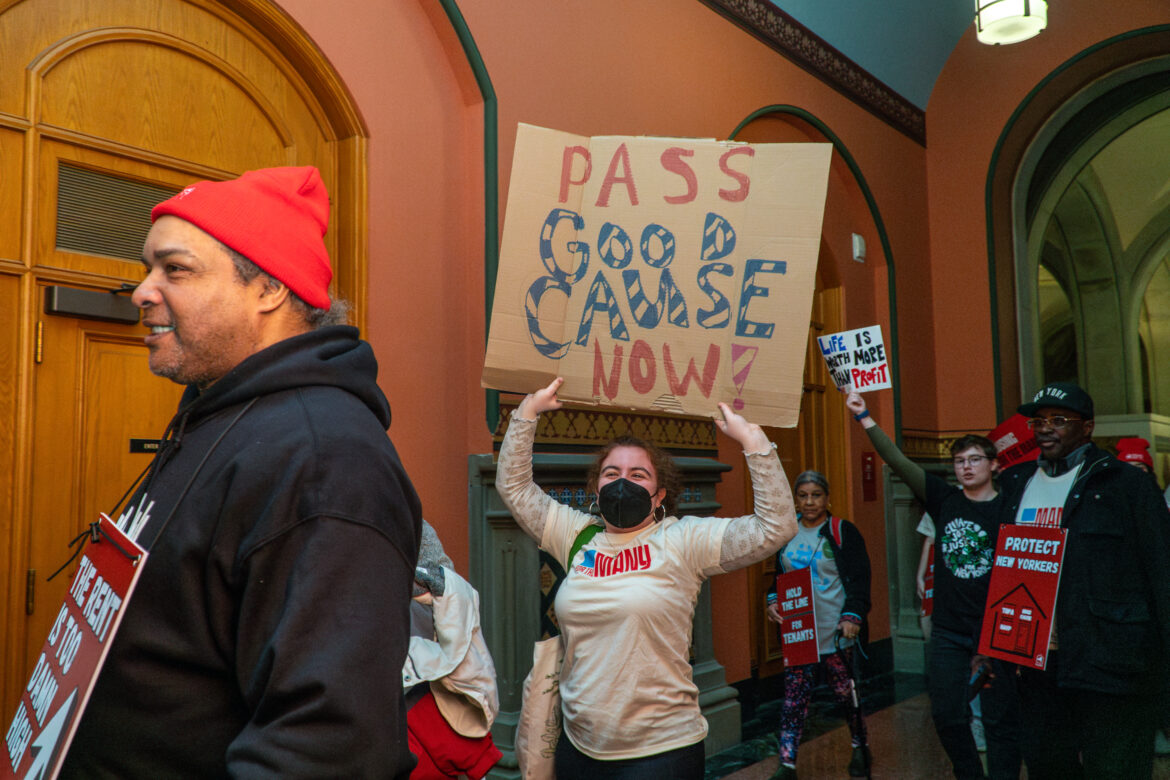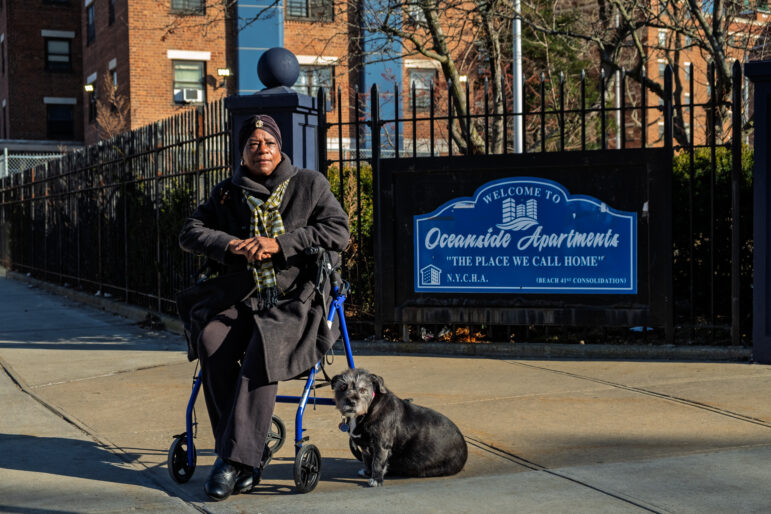Viewed in isolation, a proposal to exempt small residential portfolios from new eviction protections could exclude hundreds of thousands of New York City apartments. Perhaps more significantly, this type of estimate isn’t easy to make.

Chris Janaro
Tenant organizers with the Housing Justice for All Coalition rallying at the Capitol building in Albany on March 19, 2024.How many apartments does your landlord own?
You may not know off the top of your head, but the answer could determine your eligibility for new eviction protections under a broad state housing deal, the specifics of which are still being hammered out.
On Monday evening, Gov. Kathy Hochul announced the “parameters of a conceptual agreement” for her $237 billion budget for the coming fiscal year, including a housing plan she said will spur development and “extend protections to tenants in New York that have never been available before.”
As City Limits previously reported, the latter will be some type of defense against eviction without a designated “good cause,” albeit with more carve-outs than the legislation tenant advocates have been pushing since 2019. For example, on Monday Hochul referenced “protecting the very small landlords” in the deal.
Covered tenants will likely be able to defend against eviction so long as they keep up with rent and comply with their lease terms, and challenge rent increases above a certain threshold.
One proposal on the table as of Tuesday would exclude buildings in certain smaller real estate portfolios, according to three sources privy to the negotiations. Thresholds up for discussion include 10 or fewer units and eight or fewer units. (Hochul’s office and Senate and Assembly leaders did not immediately respond to requests for comment.)
Looking at these possibilities in isolation, a City Limits analysis estimates a portfolio exemption could exclude hundreds of thousands of New York City apartments from new tenant protections.
According to data on portfolio size from the nonprofit group JustFix’s Who Owns What tool, as much as 17 percent of the city’s roughly 1.4 million market rate rentals could be exempted under the portfolio size standard alone. Those estimates exclude rent stabilized units that already have stronger tenant protections, as well as an unknown number of small owner-occupied properties that are not required to register with the city’s Department of Housing Preservation and Development (HPD).
The average renter household in New York City has 2.5 people, meaning a carve out of over 250,000 units could exclude over half a million tenants in the five boroughs.
The data on portfolios is complicated to compile, and has some limitations, JustFix warned. Not all city rental properties are required to register with HPD and most of the information is self-reported by landlords.
The possibility of a portfolio exemption also raises a slew of enforcement questions, according to tenant advocates and real estate industry observers. Landlords can mask their identities behind limited liability companies (LLCs), making the true scope of their holdings difficult to discern.
“It can take a significant amount of technical and subject-matter expertise,” said Maxwell Austensen, a software engineer at JustFix. “We made Who Owns What to help automate this work, which historically could take days, if not longer, to do manually for each portfolio. But there’s still no publicly provided, official source of truth.”
It remains to be seen if owners will be under some obligation to disclose information to their tenants regarding their good cause eligibility.
Assembly Speaker Carl Heastie did not explicitly discuss a portfolio exemption in remarks to reporters Tuesday, though he alluded to a unique set of parameters outside of New York City, including pertaining to portfolio size.
He also said that “we want tenants to know whether they are living in a household that would be covered under tenant protections or not” and “that’s one of the language things we’re trying to figure out.”
Judith Goldiner, attorney in charge of the Civil Law Reform Unit at the Legal Aid Society, offered some suggestions for a disclosure rule, saying landlords should have to tell tenants the names behind their building’s LLC, and how many units each affiliated person owns.
“You should know when you lease up, you should know when your landlord sends a notice for eviction, and your landlord should have to prove that [you’re not covered] when they bring you to court,” she said.
But while a disclosure requirement would be welcome, a portfolio exemption would still “incentivize landlords to reduce the perceived scale of their portfolio,” Austensen of JustFix said.
A recent analysis by the good government group Reinvent Albany offers a sense of the prevalence of LLC ownership around the state, though not limited to residential properties. Over a third of properties in Manhattan are LLC-owned, the group found, far outpacing the rest of the city.
Across Albany, Buffalo, Rochester, Syracuse and Yonkers, the average LLC ownership rate is 11 percent. Outside of New York City, open data can be harder to come by, according to JustFix, making it difficult to connect properties and LLCs across the state.
New York’s brand new LLC Transparency Act would have helped renters discover who controls a given LLC—the so-called “beneficial owners”—through a publicly-searchable database.
But Hochul signed the act into law in December on the condition that the database be private, accessible only to law enforcement or government agencies, or through court order. The bill “required changes to ensure it serves the core purpose of exposing unlawful activity while balancing personal privacy,” she wrote in a memo at the time.
Brooklyn Assemblymember Emily Gallagher, who sponsored the legislation, told City Limits Tuesday that the private database will make it “much more arduous” for tenants to investigate their landlord’s portfolio size.
But Gallagher also expressed hope that it will still be useful, particularly if lawmakers commit to being proactive on their constituents’ behalf, making database requests to the Department of State and alerting the attorney general. The law isn’t set to take effect until January 2026, but Gallagher is pushing to get that date moved up.
“The Department of State is going to have to learn to give that information really rapidly, but it’s all achievable and I think it will help navigate this,” she said.
The law also includes steeper penalties than initially proposed—up to $500 per day in fines for late disclosures and authority for the attorney general to dissolve entities that don’t comply.
“It’s going to be better than the status quo,” Gallagher said.

NYS Senate Media Services
Lawmakers and housing activists at a rally to support the good cause bill last year.But Mike McKee, treasurer of Tenants PAC and a longtime proponent of the good cause bill as initially written, was skeptical. “If you want to make something unenforceable then make it complicated and make it byzantine,” he said Tuesday.
A portfolio exemption could even be difficult for landlords to understand, according to Ben Carlos Thypin, CEO of the real estate brokerage Quantierra. For example, there will have to be clear guidance on how to count units in which landlords have partial ownership.
“It seems hard to imagine that this bill will take into account all of these potential edge cases in terms of how the threshold is calculated,” he said.
Thypin has done his own rough analysis of New York City apartments potentially covered by good cause, using his company’s proprietary database. He assumed an exemption of portfolios with 10 or fewer units, as well as apartments built since 2009 and those above a high-rent threshold, based on proposals City & State previously reported.
A version of good cause with these exemptions would cover about 400,000 apartments or a little over a third of the city’s unregulated housing stock, Thypin said, stressing that the figure could change depending how final negotiations shake out.
If the portfolio exemption comes to fruition, he added, this could cue up a good test of the LLC Transparency Act, and the allowed disclosures to government agencies.
“Absent some system that the state comes out with to tell people whether a building is covered by good cause eviction, I think the net result is discouraging use of the law,” he said.
To reach the reporter behind this story, contact Emma@citylimits.org. To reach the editor, contact Jeanmarie@citylimits.org
Want to republish this story? Find City Limits’ reprint policy here.








